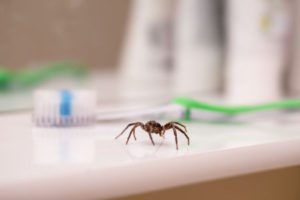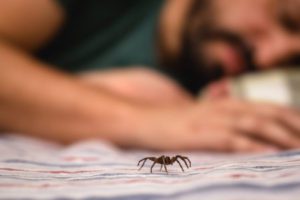INDOOR SPIDER CLEANUP AND PREVENTION
By Zachary Ciras on January 8, 2021.

Spider found in a bathroom inside of a home. Shutterstock.
Since we’re all spending a lot of time indoors these days, some of us are doing spring cleaning early, tackling some of those household chores that repeatedly get overlooked. One such chore is removing spider webs and spider egg sacs, and cleaning up spider poop in those out-of-the-way places.
WHY DO WE HAVE SPIDERS IN THE WINTER ANYWAY?
The spider evidence you are removing may be old and the spiders long gone (especially if in an area rarely inhabited), or it may be current. Spiders feed primarily on insects, so you may wonder how you could still have spiders around in the winter when there don’t seem to be any insects for food (see Spiders Are Active Indoors Year Round).
Almost every home has some insects or other small arthropods in hiding somewhere. Spiders may be feeding on insects that also can be active indoors during the winter (cockroaches, silverfish, clothes moths, carpet beetles, drain flies, food moths, even bed bugs). Or, they may be enjoying seasonal insect invaders that have moved into your home for the winter such as lady beetles, stink bugs, or seed bugs. This is where we have to point out that spiders are actually beneficial, feeding on annoying or damaging pest insects. Some people don’t even mind a few spiders as long as they know their place!
WHAT’S THE BEST WAY TO REMOVE SPIDER WEBS?
Not all spider webs belong to active spiders and the number of webs is not necessarily an indication of the number of spiders in your home. Some spiders make multiple webs or remake their webs on a regular basis (see How Do They Do That? – Spider Webs). On the other hand, not all spiders make the classic cobwebs. Some spider webs are just a flimsy tangle of silk threads that are barely noticeable, and some jumping spiders don’t really make webs at all.
Web spiders are especially difficult to kill with pesticide sprays or dusts since they spend much of their time in their webs where they have little contact with treated surfaces and they don’t groom themselves like insects. If disturbed, they may retreat into the nearest protected crevice. The best way to remove spider webs, spiders, and their egg sacs is with a vacuum tool attachment or a telescoping-handle duster brush.
SPIDER EGG SACS CAN BE OLD AND HATCHED, OR NEW
A female American house spider’s egg sac is about as big as she is, it’s light brown, almost round, and papery-looking (see What Do Spider Egg Sacs Look Like?). You’ll realize that you’ve seen these but were never exactly sure what they were. The egg sac can hatch out 100-400 baby spiders and the female can produce up to 17 egg sacs in her lifetime. The swarming, tiny, beige spider hatchlings are often mistaken for mites, ticks, or even bed bugs.
Spider egg sacs can be found in or near the web but are often tucked away in corners or hidden under objects. If you don’t bend down and look at the dark bottom sides of furniture, shelves, ledges, and other items, you will miss most of them.
As with webs, you will find more egg sacs than you have spiders. Many of the sacs will have already hatched but since it’s not easy to tell which, vacuum all the sacs up with the webs and any spiders.
IS SPIDER “POOP” EVEN NOTICEABLE?
Spiders are just as often found, along with their egg sacs, underneath furniture or items as they are in webs above. In fact, a good way to search out these hidden spiders is to look for their semi-liquid fecal droppings on floors, tabletops, or other surfaces. The spider is often resting underneath an object directly above.
Spider poop is not a solid pellet of material like mouse poop. Spiders produce pin head-size liquid fecal droplets. You will find these white to gray to brown dried fecal drips on surfaces below spider hiding or resting places. A well-fed spider can produce quite a noticeable collection of fecal spots over time. As anyone who has tried to scrub these spots away will tell you, they are extremely difficult to remove from surfaces and may leave a yellowish stain behind.
Clean-up tips? Wipe up the fecal drops before they have completely dried (good luck with that!). Different folks swear by different products but the main thing is to be careful that you don’t damage the finish of the surface during the process (see How to Clean Up Spider Droppings…Maybe). After repeatedly trying to remove spider poop stains, you will become an advocate of spider prevention as the preferred control method!
TIPS TO KEEP SPIDERS OUT OF YOUR HOME

Spider creeping near a sleeping person inside a home. Shutterstock.
Household spiders can usually be eliminated without the use of pesticides. Colonial Pest Control technicians use specialty vacuums and brushes to remove spiders and their webs, plus strategic inspections to determine why spiders are attracted to the site (see How to Reduce Spiders Around Your Home).
The spiders themselves are only part of the problem. In fact, abundant spiders are usually the result of abundant insect pests. You can vacuum webs and egg sacs and spiders, but unless you address the source of the problem, you will always have spiders.
Finding and eliminating spiders’ primary food source (insects, etc.) is a permanent solution and this is where professional intervention proves invaluable. Control can be as simple as reducing bright outside lights that attract insects, or screening vents or adding weather-stripping and thresholds to outside doors.
Ask us for advice. Colonial can help with indoor spider control.